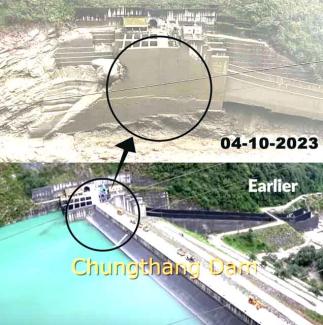In the intervening night of 3-4 October, Sikkim had to face a deluge. Breakup of a glacial lake amidst heavy rainfall was the reason for this disaster. The rapid rise in the water level of Teesta river caused the 1200 megawatt Teesta-III dam, situated half a kilometer downstream of the confluence of Lachen Chu and Lacheng Chu rivers, near Chungthang village to be totally damaged. 14 bridges were swept away, more than 100 people lost their lives which included Army personnel and 2500 people had to be relocated to relief camps. As per government estimates, more than 70 persons are still missing.
The reason being attributed to this disaster is a lake outburst in a portion of the South Lhonak lake situated in North Sikkim. According to a press release issued by Central Water Commission on 4th October, it is stated that during the night of 3rd October, a breach in this lake led to a water rise in the Teesta river at the rate of 15 metre per second. Initially, the Army and the Sikkim Disaster Management Authority attributed cloudburst for this disaster, but the Indian Meteorological Department refused to accept this argument.
It has been seen that during such disasters, either cloudburst or glacial Lake outburst are shown as the reason by the government agencies. The disaster in Sikkim has once again proved that attributing natural causes for these disasters is nothing but an attempt of falsification. It is a lame excuse to protect the profit oriented development model.
The disaster in Sikkim had been forewarned by experts. Since 2006, large-scale construction activity in the Teesta valley had raised apprehensions about the impending disaster. In an article published in the science journal Nature India in 2013, the scientists of the National Remote Sensing Centre predicted that there is a 42% chance of breach in the Lhonaklake. Reports state that in the last three decades, the Lhonak lake has been rising at 2.5 times the normal rate. The increase in the rate of melting of glaciers is being attributed to global warming. The International Centre for Integrated Mountain Development(ICIMOD), Kathmandu, in a study titled "Water, ice, society and ecosystems in the Hindu Kush Himalaya" mentions that compared to the previous decade, the 2010 decade has witnessed a 65% increase in the rate of melting of glaciers. The article further states that if the greenhouse emission was not controlled, then by 2100, 80% of the Himalayan glaciers would disappear.
The weakness in the early warning system has also been highlighted in the tragedy in Sikkim. In a report published by BBC, NDMA, Central Water Commission and the Ministry of Water Resources have no answer as to why there was no early warning system in the Lhonak lake. According to the BBC, Switzerland was assisting in setting up the early warning system but the Swiss embassy situated in Delhi had no answer as to why there was delay in commissioning the system.
Whatever may be the reason for this delay, it caused the death of many. In the 2013 Kedarnath tragedy and the 2021 tragedy of Raini Tapovan, it was the absence of an early warning system which led to the loss of many lives. According to a report published by the South Asian Networks for Dams, Rivers and People (SANDRP), the flood forecast and monitoring network of Central Water Commission is extremely poor. The report published by SANDRP on 9 October 2023 states that the CWC flood forecast website shows 18 monitoring stations on the Teesta river out of which 12 are in Sikkim and 6 in West Bengal. The report further states that out of the 12 sites in Sikkim, 5 are nonfunctional and four sites on the Teesta River have given inaccurate predictions because they are on the tributaries of Teesta River. The early warning systems and the flood monitoring systems are either absent or non-functional, though there are a number of hydroelectric projects on the river which are functional and are showcased as models of development. The cost of such irresponsible priorities is massive disasters claiming hundreds of lives and loss of property of common citizens of the country. The project on Teesta-III is a case in point. The SANDRP website while talking about the disaster in the Teesta-III project mentions that the dam at Chungthang got washed away in 10 minutes just after midnight. The 200 m long bridge connecting the power house has also been washed away. The entire power house has been submerged underwater. The dam which was to stay for 100 years could not even live 6 years of its life. This is the stark reality of the hyped up claim of sustainable development. It is important to note that other than the Chungthang dam, the control room of Teesta-V (510 megawatt) was severely damaged. The water released from the dam also damaged a portion of National Highway 10. A proposal to construct the Teesta-IV between Teesta-III and Teesta-V is awaiting clearance. The under construction Teesta-VI hydroelectric project which is downstream of Teesta-V has been submerged in debris. In spite of the colossal damage caused to the constructed and under construction projects, the government appears in no mood to review these projects. In a press statement released on October 5 by the Central Energy Ministry, it is mentioned that there will be an evaluation of the damage caused to the various hydroelectric projects in Sikkim once the flood water recedes. The statement adds that the NHPC is trying its best to operationalise these hydroelectric projects at the earliest. This statement makes it amply clear that the central government is worried about the loss caused to these projects but not bothered about the human damage caused by these projects. Nor is it bothered about the damage these projects are causing to the fragile mountains. Such a statement is similar to the one made by the Central Energy Minister RK Singh in February 2021 in Uttarakhand after the Raini Tapovan disaster, in which about 200 people lost their lives.
If this pro-corporate-contractor centric development model continues, people will continue to die and nature and environment will continue to be degraded. It is high time that these disastrous models are done away with so that our mountains, glaciers, air, water and land could be saved.









